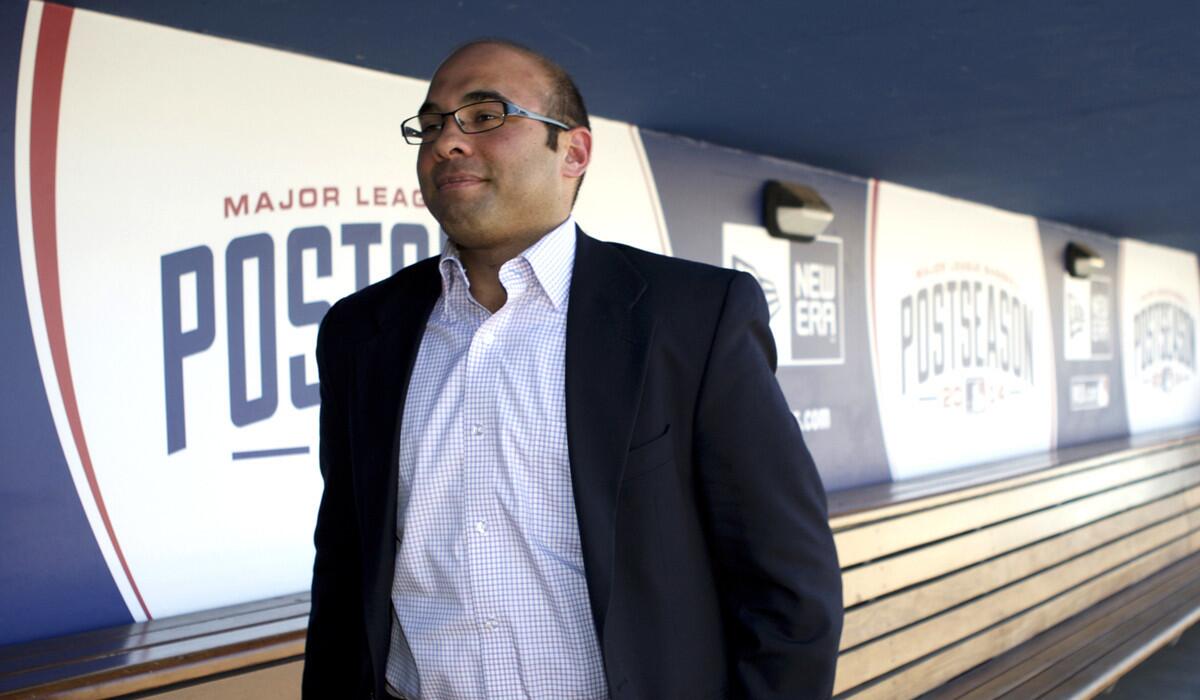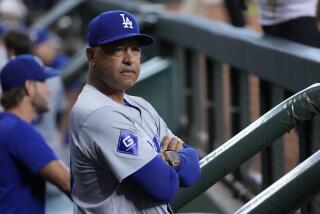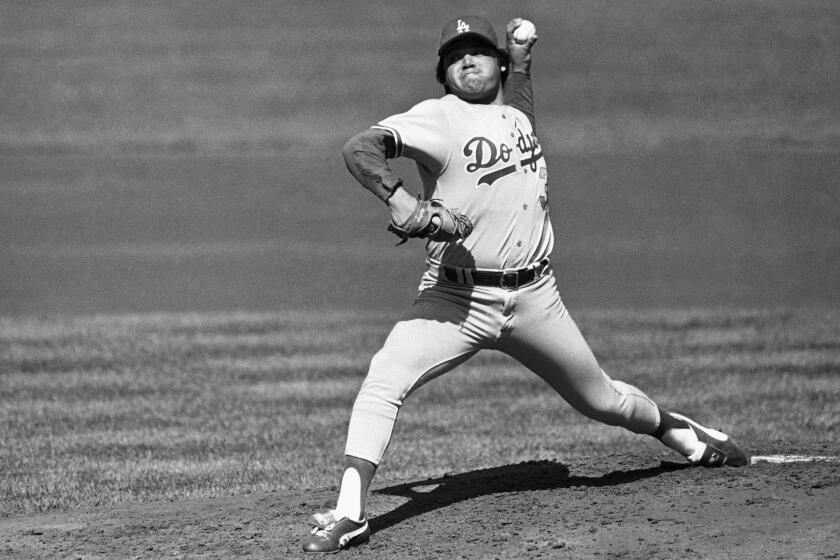Dodgers throwing dollars, not prospects, at postseason dreams

Dodgers General Manager Farhan Zaidi strolls through the dugout at Dodger Stadium last season.
Say it slowly. Savor the syllables. Cue Carl Sagan.
A third of a billion.
That is the amount the Dodgers’ owners are spending on their major league payroll this season.
One-third of a billion dollars. So far.
On the popular scale of measuring the commitment of an ownership group by its willingness to spend, Guggenheim Baseball Management might be the greatest ownership in sports history.
Do these guys even have a financial limit?
“Yeah, absolutely,” General Manager Farhan Zaidi said Friday.
And what might that limit be?
“We don’t have set numbers,” Zaidi said. “Nobody has ever mentioned a number to us.”
We should have seen this coming when Guggenheim blew away all comers in the bidding for the Dodgers — $2.15 billion for the team and half-ownership of the Dodger Stadium parking lots, another $400 million for a real estate development fund run by Frank McCourt.
In the fourth season of ownership — and the first under a front office led by Andrew Friedman, the president of baseball operations, and Zaidi — the numbers continue to astound.
The Dodgers are paying $86 million for players not to play for them this season. In nine seasons running the Tampa Bay Rays, Friedman never had a player payroll higher than $77 million.
The Dodgers are projected to pay $43 million in luxury taxes this season. No team has paid more than $34 million in luxury taxes in a single season.
“It’s the TV contracts,” Angels closer Huston Street said.
The Angels got $3 billion for theirs. The Dodgers got $8 billion for theirs.
“That’s the reality that the TV money is bringing to the game,” Street said. “As players, you love to see the ownership groups spending that on the players. I feel like the Angels organization is committed to doing that.
“It’s obvious with the Dodgers.”
What is more compelling than the sheer amount of money is how the Dodgers are spending it. In 2012, when Guggenheim told then-GM Ned Colletti to “think big,” the Dodgers took on $260 million in contracts from the Boston Red Sox — assuming the contracts of Josh Beckett and Carl Crawford in order to get Adrian Gonzalez.
Beckett and Crawford, at least, played for the Dodgers. In this week’s trades, the Dodgers assumed Michael Morse’s contract to get Mat Latos from the Miami Marlins, then dumped Morse. They assumed Bronson Arroyo’s contract and paid all of Hector Olivera’s signing bonus to get Alex Wood, Luis Avilan and Jim Johnson from the Atlanta Braves, even though Olivera never played for the Dodgers and Arroyo might never play for them.
“It’s obviously a plus to be able to use money instead of players to get the things you need to get,” Gonzalez said.
“I think our financial flexibility just gives us another degree of freedom to work with when we are making deals,” Zaidi said. “It would be negligent of us not to explore that.”
In lieu of prospects as currency, the Dodgers prefer to use actual currency. While shortstop Corey Seager and pitcher Julio Urias were widely labeled the two untouchables, the Dodgers did not trade any prospects beyond Olivera, who is 30.
“They value their guys as if every one is Babe Ruth or Cy Young,” an executive from another major league club said Friday.
Zaidi denied that allegation, but he did not deny his satisfaction that the Dodgers had gotten better — without getting David Price or Cole Hamels, but also without giving up any of their top young prospects.
“If you tell me I get to keep my top dozen prospects, I’m pretty happy about that,” Zaidi said.
With every top prospect they keep, the Dodgers say they are one step closer to their long-promised sustainable future, when the kids take the field and the payroll finally comes down. Zaidi is not apologizing for leveraging the Dodgers’ financial might to buy players and draft picks without surrendering prospects.
“We’re going to operate within the boundaries of the rules, as long as those are the rules,” he said.
The alarm bells rang in New York this week not because of the behavior of the Dodgers, but because of the behavior of the Marlins. The players’ union has renewed its scrutiny of the Marlins’ operations after this week’s three-way trade, in which Miami traded players and a draft pick to shed salary, with the return limited to low-level minor leaguers. The Dodgers are covering 25% of the Marlins’ player payroll this season.
For all the creativity Friedman and Zaidi have shown, and for the endless supply of Dodgers dollars their bosses have permitted them to spend, the highest-spending team in the major leagues has won the World Series once since 2000. Imagination and wealth are a winning combination, but not the only one.
“Everybody has their own way of going about it,” Gonzalez said. “There’s only going to be one team that does it right, and that’s whoever wins the World Series.”
Twitter: @BillShaikin
MORE FROM SPORTS
Steve Sarkisian still not feeling the love at USC
Analysis: Clippers are deep in talent — and that raises questions
Bethe Correia vows to take fight to Ronda Rousey in UFC title match
More to Read
Are you a true-blue fan?
Get our Dodgers Dugout newsletter for insights, news and much more.
You may occasionally receive promotional content from the Los Angeles Times.











